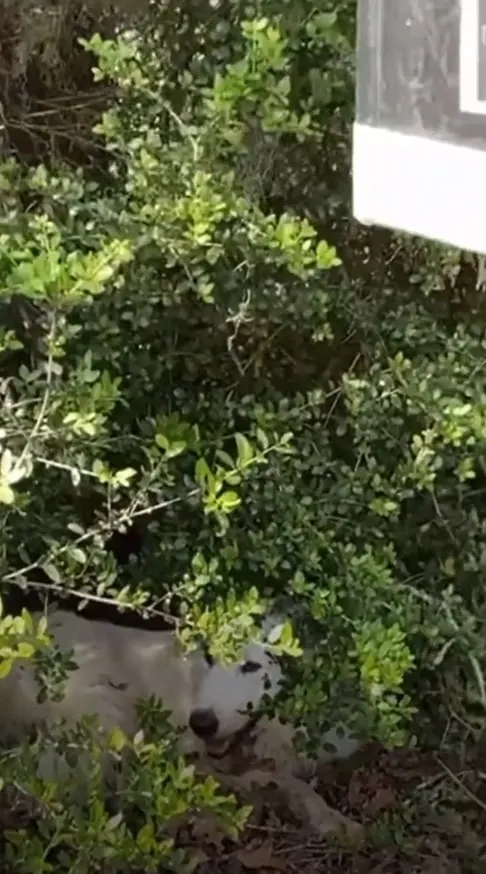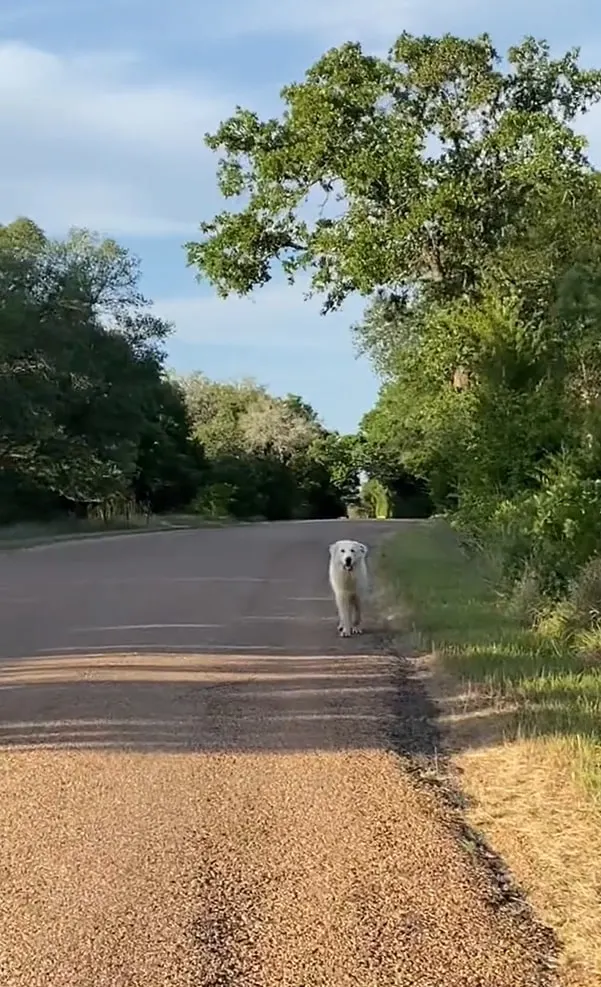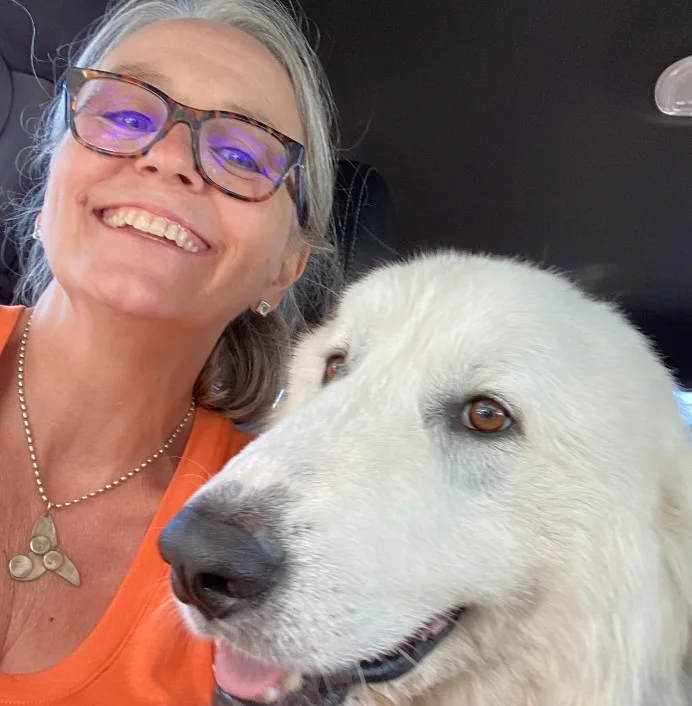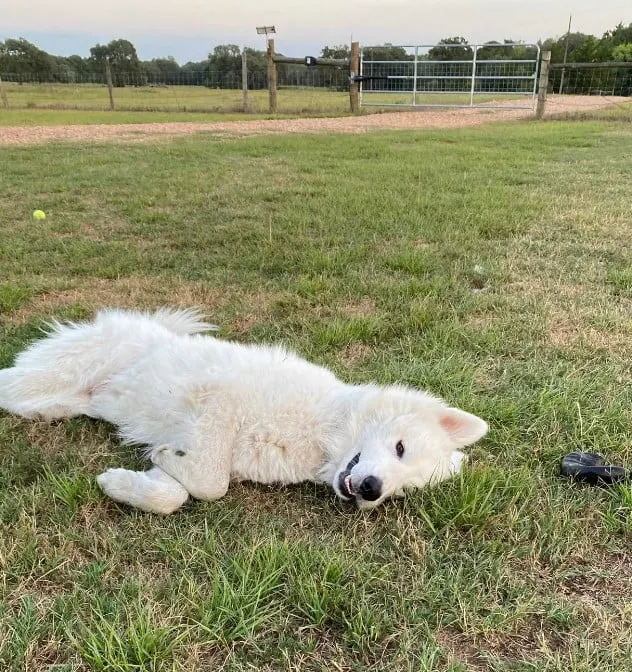It was supposed to be just a regular night for Jen Edmondson, a woman living in southeastern Texas. As she went outside the house, she walked right by her mailbox, spotting two big black eyes peeking from the nearby bushes.
Quite confused at first, she decided to step a little closer, and there he was – a pawdorable white doggo practically begging for help through his kind stare…
He Was All Alone In This World

The dog was clearly lost, but assuming from his calm and tender demeanour, Jen realized he had a family before. She immediately took a video of him and posted it on social media, inquiring about his potential owners.

“Found him alone and wandering. Turns out he’s super sweet, but no one has claimed him. So we’re fostering him with a local rescue organization,” wrote Jen on her TikTok account.
As it turned out, many more people saw the dog wandering the streets around the town, but no one exactly knew whether or not he belonged to someone.
So, Jen decided to step in!
Jen Steps In As A Temporary Foster

After taking him in temporarily, Jen subjected the doggo to his first initial checkup. According to the vet, the dog was a two-year-old Great Pyrenees!
He suggested that Jen foster the dog through Columbus Rescue Dogs, from Columbus, Texas, since no one else claimed him. And, she did it!
However, there was a teeny, tiny problem for Jen!
Even though everything started out as a temporary solution, she slowly started falling in love with the dog, which she later named Gibbous (after the gibbous moon that shone in the sky the night she found him).
“If I’m being honest, I’m falling in love! He is the sweetest dog and he’s always smiling at me! So we’re getting pretty close to a foster fail here. I’m too vested in this sweet, happy gentle giant,” wrote Jen.
Every new day, Gibbous felt more comfortable around his foster mom, and he didn’t seem to let go easily. And, neither did she!
Gibbous – A Pawdorable Foster Fail

After a few months of fostering and preparing Gibbous for potential adopters – Jen made the decision to adopt Gibbous for good!
She couldn’t stand the idea of not being around him anymore, and since no one else stepped forward and claimed this gorgeous gentle giant – she was more than happy to keep him in the family!
And, it seems that Gibbous didn’t mind that idea at all!
Enjoying His Unexpected Home
He seems to enjoy his spacious yard very much! But, on top of all that – he loves Jen the most.
He’s completely into car rides, long walks, and frolicking around with his new momma. He sometimes may be stubborn, but then again – he just gets away with it due to his adorable smile!
“Life is good for this rescue foster Gibbous. Hes sooooo good at car rides, outdoor dining, loving people,” says his momma.

We’re so glad to see Gibbous happy in his new home, and we wish him and his momma a long, joyful life together!
Aside from their TikTok, you can follow Jen and Gibbous’ adventures on their Instagram, too.
If you’ve noticed a flurry of fur around your home, you’re not alone. Dog shedding can sometimes feel like an endless battle, leaving you wondering why your furry friend is leaving a trail of hair wherever they go. As a seasoned dog trainer, I’ve seen this issue crop up time and time again, causing frustration for many pet owners like yourself.
Before you start considering extreme measures like giving your pup a buzz cut, it’s essential to understand the reasons behind excessive shedding. From seasonal changes to dietary factors, various elements can contribute to your dog’s shedding woes. In this article, we’ll explore the common culprits behind your dog’s shedding habits and provide you with practical tips to help manage this hairy situation.
Understanding Dog Shedding
What Is Shedding and Why Does It Happen?
Dog shedding is a natural process where your furry companion loses old or damaged hair to make way for new growth. Shedding helps regulate your dog’s body temperature, keeps the skin healthy, and removes dead hair. It’s essential to note that all dogs shed to some extent, but the amount can vary based on breed, health, and other factors.
Factors That Influence Shedding in Dogs
Several factors can influence how much your dog sheds. Genetics play a significant role, with certain breeds prone to heavier shedding than others. Seasonal changes, hormones, nutrition, and stress levels can also impact shedding patterns. Additionally, underlying health issues such as infections or allergies may cause excessive shedding. Proper grooming, a balanced diet, and regular vet check-ups can help manage shedding and keep your dog’s coat healthy.
Common Causes of Excessive Shedding
Seasonal Changes and Shedding
Seasonal shedding is a common occurrence in dogs, especially during the transition between warm and cold weather. As the daylight hours decrease, your dog’s coat may respond by shedding more to adjust to the changing temperatures. This shedding is often known as “blowing coat” and is a natural process that helps your dog prepare for the upcoming season. While all dogs shed, certain breeds with double coats may shed more noticeably during these seasonal changes. So, if you notice a sudden increase in shedding during specific times of the year, it’s likely due to seasonal factors.
Health-Related Causes of Shedding
Excessive shedding can also be a sign of underlying health issues in your dog. Conditions such as allergies, infections, parasites, or hormonal imbalances can lead to abnormal hair loss. If your dog is shedding excessively and you notice other symptoms like skin irritation, redness, or unusual behavior, it’s essential to consult your veterinarian for a proper diagnosis. Addressing the underlying health issue is crucial in managing your dog’s shedding and ensuring their overall well-being.
Nutrition and Its Impact on Dog Shedding
Your dog’s diet plays a significant role in their overall health, including the condition of their coat. A balanced and nutritious diet is essential for maintaining healthy skin and a shiny coat. If your dog lacks essential nutrients like Omega-3 fatty acids, vitamins, and protein, it can lead to dry, dull fur and increased shedding. Ensuring your dog is eating high-quality food suitable for their breed and age can help reduce excessive shedding. Additionally, proper hydration is vital for keeping your dog’s skin and coat hydrated, ultimately minimizing shedding. Remember, a healthy diet equals a healthy coat for your furry friend.
How to Manage Your Dog’s Shedding
Regular Grooming Techniques
To minimize shedding, regular grooming is essential. Brush your dog’s coat frequently to remove loose fur and prevent mats. Use a deshedding tool suitable for your dog’s breed to effectively reduce shedding. Bathing your dog with a mild shampoo can also help maintain a healthy coat and decrease shedding.
Choosing the Right Diet for Your Dog
Proper nutrition plays a vital role in controlling shedding. Opt for high-quality dog food with essential nutrients like omega-3 fatty acids and biotin that promote healthy skin and coat. Ensure your dog stays hydrated, as water is crucial for skin health. A balanced diet will help reduce excessive shedding and keep your dog’s coat shiny.
When to See a Veterinarian
If you notice excessive shedding that doesn’t improve with grooming or dietary changes, it’s time to consult a veterinarian. Allergies, infections, or underlying health issues could be the cause of abnormal shedding. A vet can assess your dog’s overall health and recommend appropriate treatment to address the shedding problem promptly.
Products That Can Help With Shedding
Shedding Tools and Brushes
To tackle your dog’s shedding issues, investing in the right shedding tools and brushes can make a significant difference. Tools such as slicker brushes, undercoat rakes, and deshedding gloves are designed to remove loose fur effectively. A slicker brush is ideal for removing mats and tangles in your dog’s coat, while an undercoat rake helps in getting rid of loose undercoat hair. Deshedding gloves offer a hands-on approach to grooming, allowing you to massage your dog while capturing loose fur. Using these tools regularly can help reduce shedding and keep your dog’s coat healthy.
Supplements for Healthy Coat
Supplements play a vital role in promoting a healthy coat and reducing shedding. Omega-3 fatty acids are essential for maintaining skin and coat health, reducing inflammation, and preventing excessive shedding. Look for supplements that contain fish oil or flaxseed oil to incorporate these beneficial fatty acids into your dog’s diet. Additionally, biotin supplements can help strengthen your dog’s coat and reduce brittleness, leading to less shedding. Consult your veterinarian to determine the right supplements and dosage for your dog to improve their coat condition and minimize shedding.
Conclusion
Your furry friend shedding a lot can be a common concern, but understanding the reasons behind it can help you manage it better. Factors like genetics, nutrition, and health play a significant role in your dog’s shedding patterns. By focusing on proper grooming, regular vet check-ups, and a balanced diet, you can help reduce excessive shedding. Tools like slicker brushes and undercoat rakes can be your go-to for removing loose fur effectively. Additionally, supplements such as omega-3 fatty acids and biotin can promote a healthy coat and minimize shedding. Remember, consulting your vet for the right supplements and dosage is key. With a little extra care and attention, you can keep your pup’s shedding in check and maintain a happy, healthy pet.
Frequently Asked Questions
What factors contribute to excessive shedding in dogs?
Excessive shedding in dogs can be caused by factors such as seasonal changes, genetics, health issues like allergies or hormonal imbalances, poor nutrition, and lack of grooming.
How can grooming help manage shedding in dogs?
Regular grooming through brushing and deshedding tools can help manage shedding by removing loose fur, preventing mats, and promoting a healthy coat.
What are some effective shedding tools for dogs?
Effective shedding tools for dogs include slicker brushes, undercoat rakes, shedding blades, and grooming gloves, which help remove loose fur and reduce shedding.
Are supplements recommended for reducing shedding in dogs?
Supplements like omega-3 fatty acids and biotin can help promote a healthy coat and reduce shedding in dogs, but it is advisable to consult a veterinarian for the right supplements and dosage.
[no_toc]

Hey there, I’m Janet Brooks, a dog-loving student from California. I’m all about helping pups in need, especially those without homes. Me and my awesome friends work together to give shelter and love to stray dogs. Oh, and I also write blogs about dogs to share helpful info.